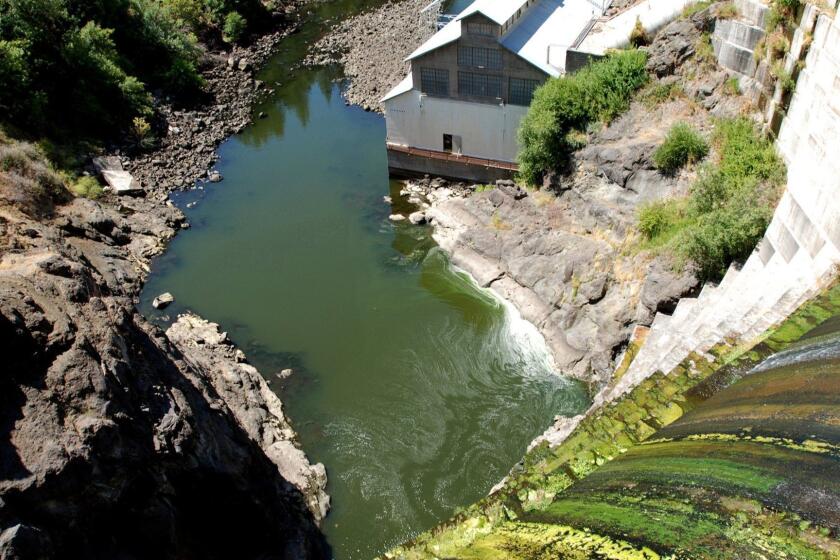Federal regulators throw wrench into Klamath River dam-demolition plan

- Share via
PORTLAND, Ore. — Federal regulators have thrown a significant curveball at a coalition that has been planning for years to demolish four massive hydroelectric dams on a river along the Oregon-California border in order to save salmon populations that have dwindled to almost nothing.
The deal, which would be the largest dam demolition project in U.S. history, relies on a delicate calculus: The power company that operates the Klamath River dams will transfer its hydroelectric license and contribute $250 million in order to remove itself from the demolition project and avoid any further liability or unanticipated costs.
The Federal Energy Regulatory Commission, however, approved the license transfer Thursday on the condition that PacifiCorp remain a co-licensee along with the Klamath River Renewal Corp., the nonprofit coalition assembled to oversee the dams’ demolition.
That stipulation could kill or drastically alter the deal, because removing PacifiCorp entirely protects the utility’s ratepayers better — an element that was necessary to gain the support from public utility commissions in both Oregon and California.
“Although we are generally satisfied that the Renewal Corporation has the capacity to carry out the proposed decommissioning, for the reasons discussed above, we find that the public interest would be best served by approving a partial transfer of the license and requiring PacifiCorp to remain as a co-licensee,” the commission wrote in a 31-page ruling.
The commission’s decision could be devastating for Northern California tribes that rely on salmon if it sinks the long-negotiated deal to tear down the dams, which block the migration of fish along miles of the Klamath.
In 2021, four large dams on the Klamath River are due to be demolished, in part to revive the river and Klamath Basin salmon.
In a statement, a coalition of tribes, environmentalists and salmon-fishing interests said although the ruling was a twist, they were optimistic because the commission found that “there is a significant likelihood KRRC will complete the dam removal process without relying on PacifiCorp for additional funding or expertise.”
“We can work with this,” Karuk Chairman Russell “Buster” Attebery said. “We understand that we will need to reconvene settlement parties and make adjustments as needed to reflect PacifiCorp’s goals. We remain committed to our partnership with PacifiCorp as we remain committed to Klamath dam removal.”
The ruling nonetheless puts PacifiCorp in an awkward position. The dams currently make up just a small part of the utility’s power portfolio. But under federal law, if it retains the hydroelectric license, it will have to pay itself to install fish ladders to help the imperiled salmon return to their spawning grounds upstream — an amount likely far greater than the $250 million now in question.
PacifiCorp said in a statement that the ruling denied its customers the protections it had negotiated which were one of the “bedrock principles” of the agreement. “PacifiCorp is continuing to fully examine the order and will consult with our settlement partners to assess its impact,” the utility said. “We expect to reconvene with our settlement parties to determine next steps for continued agreement implementation.”
The demise of a deal to end decades of feuding on the Klamath River could rekindle old battles over water use and dams in a remote corner of California.
The Klamath River Renewal Corp. said in a short statement that it was reviewing the order with its partners to determine the next steps.
The project, estimated at nearly $450 million, would reshape California’s second-largest river and empty giant reservoirs. It could also revive plummeting salmon populations by reopening hundreds of miles of potential habitat that has been blocked for more than a century, bringing relief to a half-dozen tribes that rely on salmon fishing that are spread across hundreds of miles in southern Oregon and northern California.
The transfer of PacifiCorp’s hydroelectric license was seen as the first major hurdle to getting the dams removed on the lower reaches of the Klamath. Federal regulators must also approve a request to decommission the dams before work can begin, possibly as early as 2022.
The structures at the center of the debate are the four southernmost dams in a string of six constructed in southern Oregon and far northern California beginning in 1918.
Toward a more sustainable California
Get Boiling Point, our newsletter exploring climate change, energy and the environment, and become part of the conversation — and the solution.
You may occasionally receive promotional content from the Los Angeles Times.
They were built solely for power generation. They are not used for irrigation, they are not managed for flood control, and none has “fish ladders,” concrete chutes fish can pass through.
Two dams to the north are not targeted for demolition. Those dams have fish passage and are part of a massive irrigation system that straddles the Oregon-California border and provides water to more than 300 square miles of alfalfa, potatoes, barley and other crops.
More to Read
Sign up for Essential California
The most important California stories and recommendations in your inbox every morning.
You may occasionally receive promotional content from the Los Angeles Times.















